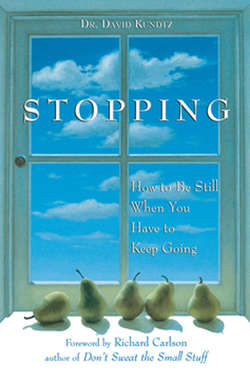Читать книгу Stopping - David Kundtz - Страница 21
На сайте Литреса книга снята с продажи.
ОглавлениеExcept for the point,the still point,There would be no dance,and there is only the dance.
T. S. ELIOT, Four Quartets
13
Stillpoints: The Heart and Soul of Stopping
Stillpoints are the expression of Stopping that can be used most often and that forms the basis, or undergirding, of all Stopping. Stillpoints are quick and focused. Creating Stillpoints during the day is fundamental to the incorporation of Stopping into one's life. They grow by accumulation and thus are the backbone that holds up the structure. A day with fifteen Stillpoints will make you much more peaceful, satisfied, and calm, no matter how much you've had to do, how many people you've had to attend to, or how many fires you've had to put out. Stillpoints also bring you closer to joyful anticipation of the longer Stoppings.
The overwhelming advantage of Stillpoints—especially compared to meditation and other time-consuming systems of quieting—is that they can be incorporated into your life with minimal disruption and maximum effect. You can be with someone constantly for a whole day and that person would never know that during the day you had been renewed and refreshed by fifteen or twenty Stillpoints. I do it all the time:
As I am presenting a seminar to forty nurses, at least ten times during the presentation, I do a Stillpoint. I take a deep breath, focus in, remind myself of what I want to create in this seminar and what I want to offer the participants, and then I go back to what I was doing. This takes a few seconds and the participants experience it only as a brief pause.
Stillpoints are life's little moments of gold that, when taken together, can give brilliance and joy to otherwise dull days. Stillpoints are the little times, brief interludes, quick respites, one minute breaks, breathers, intermissions, and lulls.
But they are also intentional and are chosen for a specific purpose. They, as all Stopping, consist as much as possible of doing nothing and of quietude.
What you do during a Stillpoint is simple: You stop doing whatever you're doing, sit or stand, take a deep breath with your eyes open or closed, focus your attention inward, and remember what you need to remember. Stop, breathe, and remember. The remembering part is very flexible, it can mean recalling a belief or event that motivates you. But it can also mean remembering a prayer for strength or peace, a message you need to hear at the moment like “you can do it,” or a self-encouragement like “you are okay.” Stop, breathe, and remember. Here are some examples of Stillpoints:
You are on the bus (or train or plane) and are staring ahead of you, perhaps focusing on the back of the seat in front of you. You begin by simply noticing your breathing for a few moments. Then briefly bring to mind some of the people that are very important to you: parents, children, spouse or partner, or friends. After a moment or two of this, simply smile, softly.
You are at the copy machine (or fax machine or on-line or in line) waiting for it to do what it is supposed to do. You relax your shoulder muscles, take a slow, deep breath with your eyes open or closed, and think of one thing for which you are thankful, for example: “I am so thankful that I have a friend like Maggie.”
The words from T. S. Eliot's poem at the beginning of the chapter are profoundly fitting for an understanding of Stillpoints. If it were not for the still point, there would be no dance. Dancing cannot continue indefinitely. There must be a point at which the dancing body stops and rests. It is that point and that time of stillness that gives energy to the dance, and the dance—life!—is all there is.
So, Stillpoints have a physical part (being still and breathing) and a spiritual part (remembering, praying, thankfulness, or other words that are good for you to hear).
Simple, isn't it? The very essence of Stillpoints is deep, intentional breathing and a moment of quiet recollection. Since breathing is of the essence in Stillpoints, this is a good time to learn the intentional breath.
